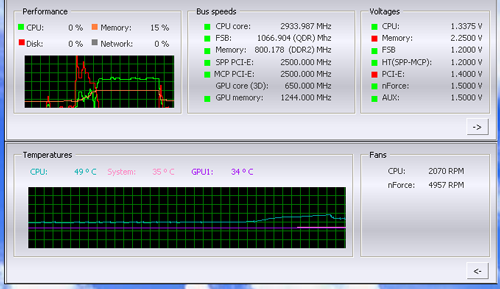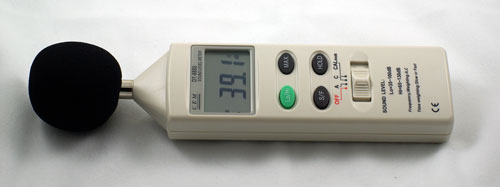Value Cooling: Two Towers for under $30
by Wesley Fink on January 23, 2007 3:50 AM EST- Posted in
- Cases/Cooling/PSUs
CPU Cooling Test Configuration
A requirement for any cooling test bed is a reliable utility for measuring CPU temperature and fan speed. The utility also must be usable while other programs are running so the impact of stress testing can be assessed. After evaluating a number of Intel 975/965 and NVIDIA 680i motherboards the decision was reached to use the NVIDIA 680i as the cooling test bed. This was primarily based on the excellent temperature measurement utility, NVIDIA Monitor, which is part of the nTune program.

NVIDIA Monitor has a drop-down pane for temperature measurement which reports CPU, System, and GPU measurement. At this point we will concentrate primarily on CPU temperature with listings of system temps for reference. In addition to the real-time temperature measurement, NVIDIA Monitor also has a logging feature which can record temperature in a file in standard increments (we selected every 4 seconds). This allows recording of temperatures during testing and play back, for example, of stress test results that can then be examined when the stress tests are completed. There is also the handy reference of speeds and voltages in the top pane to confirm the test setup.
Other components in the cooling test bed are generally the same as those used in our motherboard and memory test bed:
We first tested the stock Intel cooler at standard X6800 speed, measuring the CPU temperature at idle and while the CPU was being stressed. We stressed the CPU by running continuous loops of the Far Cry River demo. The same tests were repeated at the highest stable overclock we could achieve with the stock cooler. Stable in this case meant the ability to handle our Far Cry looping for at least 30 minutes.
The same tests were then run on the cooler under test at stock, highest stock cooler OC speed (3.73GHz), and the highest OC that could be achieved in the same setup with the cooler being tested. This allows measurement of the cooling efficiency of the test unit compared to stock and the improvement in overclocking capabilities, if any, from using the test cooler.
Noise Levels

In addition to cooling efficiency and overclocking abilities, users shopping for CPU cooling solutions may also be interested in the noise levels of the cooling devices they are considering. Noise levels are measured using a C. E. M. DT-8850 Sound Level meter. This meter allows accurate sound level measurements from 35bdB to 130dB with a resolution of 0.1dB and an accuracy of 1.5dB. This is sufficient for our needs in these tests, as measurement starts at the level of a relatively quiet room. Our own test room, with all computers and fans turned off, has a room noise level of 36.4dB.
Our procedures for measuring cooling system noise are described on page 6 along with noise results comparing the stock Intel cooler to the tested coolers.
A requirement for any cooling test bed is a reliable utility for measuring CPU temperature and fan speed. The utility also must be usable while other programs are running so the impact of stress testing can be assessed. After evaluating a number of Intel 975/965 and NVIDIA 680i motherboards the decision was reached to use the NVIDIA 680i as the cooling test bed. This was primarily based on the excellent temperature measurement utility, NVIDIA Monitor, which is part of the nTune program.

NVIDIA Monitor has a drop-down pane for temperature measurement which reports CPU, System, and GPU measurement. At this point we will concentrate primarily on CPU temperature with listings of system temps for reference. In addition to the real-time temperature measurement, NVIDIA Monitor also has a logging feature which can record temperature in a file in standard increments (we selected every 4 seconds). This allows recording of temperatures during testing and play back, for example, of stress test results that can then be examined when the stress tests are completed. There is also the handy reference of speeds and voltages in the top pane to confirm the test setup.
Other components in the cooling test bed are generally the same as those used in our motherboard and memory test bed:
| Cooling Performance Test Configuration | |
| Processor: | Intel Core 2 Duo X6800 (x2, 2.93GHz, 4MB Unified Cache) |
| RAM: | 2x1GB Corsair Dominator PC2-8888 (DDR2-1111) |
| Hard Drive: | Hitachi 250GB SATA2 enabled (16MB Buffer) |
| Video Card: | 1 x EVGA 7900GTX - All Standard Tests |
| Platform Drivers: | NVIDIA 9.53 |
| NVIDIA nTune: | 5.05.22.00 (1/16/2007) |
| Video Drivers: | NVIDIA 93.71 |
| CPU Cooling: | Thermalright MST-9775 Scythe Katana Tuniq Tower 120 Intel Stock HSF for X6800 |
| Power Supply: | OCZ PowerStream 520W |
| Motherboards: | EVGA nForce 680i SLI (NVIDIA 680i) |
| Operating System: | Windows XP Professional SP2 |
| BIOS: | Award P24 (1/12/2007) |
We first tested the stock Intel cooler at standard X6800 speed, measuring the CPU temperature at idle and while the CPU was being stressed. We stressed the CPU by running continuous loops of the Far Cry River demo. The same tests were repeated at the highest stable overclock we could achieve with the stock cooler. Stable in this case meant the ability to handle our Far Cry looping for at least 30 minutes.
| X6800 CPU Operating Temperature Standard Intel Heatsink/Fan (Ambient Temperature 21C (70F) |
||
| CPU | System | |
| IDLE 2.93GHz | 41C (106F) | 32C (90F) |
| STRESS 2.93GHz | 56C (133F) | 33C (91F) |
| IDLE 3.73GHz | 56C (133F) | 37C (99F) |
| STRESS 3.73GHz | 71C (160F) | 38C (100F) |
The same tests were then run on the cooler under test at stock, highest stock cooler OC speed (3.73GHz), and the highest OC that could be achieved in the same setup with the cooler being tested. This allows measurement of the cooling efficiency of the test unit compared to stock and the improvement in overclocking capabilities, if any, from using the test cooler.
Noise Levels

In addition to cooling efficiency and overclocking abilities, users shopping for CPU cooling solutions may also be interested in the noise levels of the cooling devices they are considering. Noise levels are measured using a C. E. M. DT-8850 Sound Level meter. This meter allows accurate sound level measurements from 35bdB to 130dB with a resolution of 0.1dB and an accuracy of 1.5dB. This is sufficient for our needs in these tests, as measurement starts at the level of a relatively quiet room. Our own test room, with all computers and fans turned off, has a room noise level of 36.4dB.
Our procedures for measuring cooling system noise are described on page 6 along with noise results comparing the stock Intel cooler to the tested coolers.










28 Comments
View All Comments
Vidmar - Wednesday, January 24, 2007 - link
Thanks for the info. Now I wonder if someone is making a CPU cooler where the heatpipes are setup to be in a somewhat vertical orientation when the case is vertical?If you look at some GPU and chipset heatpipe coolers they obviously had that in mind with their design. Hot gas will flow up, gravity will pull the cool liquid down.
I would be willing to bet (based upon the heatpipe design) that Thermalright MST-9775 would have done better in a horizontal orientation than when in a vertical orientation. Can you re-test the Thermalright MST-9775 in a vertical orientation and see if it made any difference?
Thanks!
Vidmar - Wednesday, January 24, 2007 - link
That should have been "Can you re-test the Thermalright MST-9775 in a horizontal orientation and see if it made any difference?"anandtech02148 - Tuesday, January 23, 2007 - link
just curious, with a 520wtt psu, does psu fan spin constantly?the hardwares you have seems to indicate this will utilized 80% of the psu, what's the total load power for this?
will this run stable if you put a 8800gtx instead of 7900gtx?
now i can visit Anandtech too for cooler reviews instead of Frostytech.com, great start with the under $30 coolers
Wesley Fink - Tuesday, January 23, 2007 - link
The OCZ 520w PS handles a pair of overclocked 7900GTX in SLI mode just fine. We have destoyed power supplies with higher wattage ratings with this same configuration. It is also quiet for a PS, which is why it is also used in the hard drive test bed. We had no problem with a single 8800GTX in this test rig, but we have not yet tried 8800GTX SLI in this rig.ninethirty - Tuesday, January 23, 2007 - link
Wondering -- for those of us with space-challenged cases, could you mention the height of the coolers in question? For people who can't fit a Tuniq Tower, the limitation is likely to be height.If it's already mentioned somewhere, then I apologize for missing it.
Wesley Fink - Tuesday, January 23, 2007 - link
The Katana is 130mm tall (5.11") and the standard Thermalright MST-9775 is 71mm (2.8"). Thermalright also makes a shorter OEM version of the MST-9775 called the MST-9775 LE that is said to fit any case configuration available.The Tuniq Tower 120 in contrast is 155mm tall and mid-tower cases are said to be 190mm on average in the heatsink height dimension.
yyrkoon - Tuesday, January 23, 2007 - link
I second that motion. I have an Lian Li PC-G50, and the PSU sits right above the CPU, only aftermarket cooler I can think of that may fit, would be the Ole Gigabyte one (which if memory serves, it was a pretty good cooler).banshee164 - Tuesday, January 23, 2007 - link
No offense guys, but aren't you just a little behind with the heatsinks here? The Katana has been out for a year & a half now, and the MST-9775 has been around since the summer...Wesley Fink - Tuesday, January 23, 2007 - link
While the Katana has been out for a year and a half, most earlier reviews tested it on the hot Pressler or a Socket 939 AMD. Performance on the Core 2 Duo is quite different, and C2D has only been available about 6 months.We are testing some of the older and more popular coolers that are still available because what was true of the Katana on Pressler or AMD is certainly NOT the case on Core 2 Duo.
JarredWalton - Tuesday, January 23, 2007 - link
If you've been around AnandTech for a while, you know we haven't done cooling reviews in quite some time. The idea is to establish a baseline of testing results for some of the popular coolers, even if they've been out a while and over time we will be adding more cooler results. Basically, we have to start somewhere and move forward. Luckily, unlike motherboards, GPUs, and some other components, HSFs tend to have a pretty long shelf-life (at least for the effective solutions).